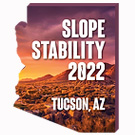Session
Rock Mass Characterization and Data Uncertainty I, Verbena Room
Abstract Summary
Knowing what the representative physico-mechanical properties of a rock mass are at any point in time, is required for successful rock engineering. These properties are commonly represented in the “geotechnical domain model” format, for which the input layers often include lithology, alteration, major structures, rock mass fabric, and hydrogeology. However, the rock mass properties change once disturbed by mining, and these changes need to be reflected in the model in some way. The model layers, as developed during the pre-mining design phases, are often not systematically updated as the project advances, which creates challenges for on-going risk assessment. The transient conditions which influence rock mass strength and performance, are mostly related to water quantity and pressure, in-situ and induced stresses, and geochemical processes. Engineers need to adjust their thinking about how to domain and categorize rock masses – by accounting for where and on what timescale these changes occur.
We propose that the input layers in the geotechnical domain model should be arranged in increasing levels of transience, from lithology on the one end of the spectrum, to water, stress, and weathering influences on the other. The domains should be established to characterize potential zones of rock quality decay within mining induced damage zones that can be updated over time, which will allow for the quantification of the rock mass strength and potential performance characteristics during and after the life-of-mine.
Authors
Click here to view other presentations at this event.



